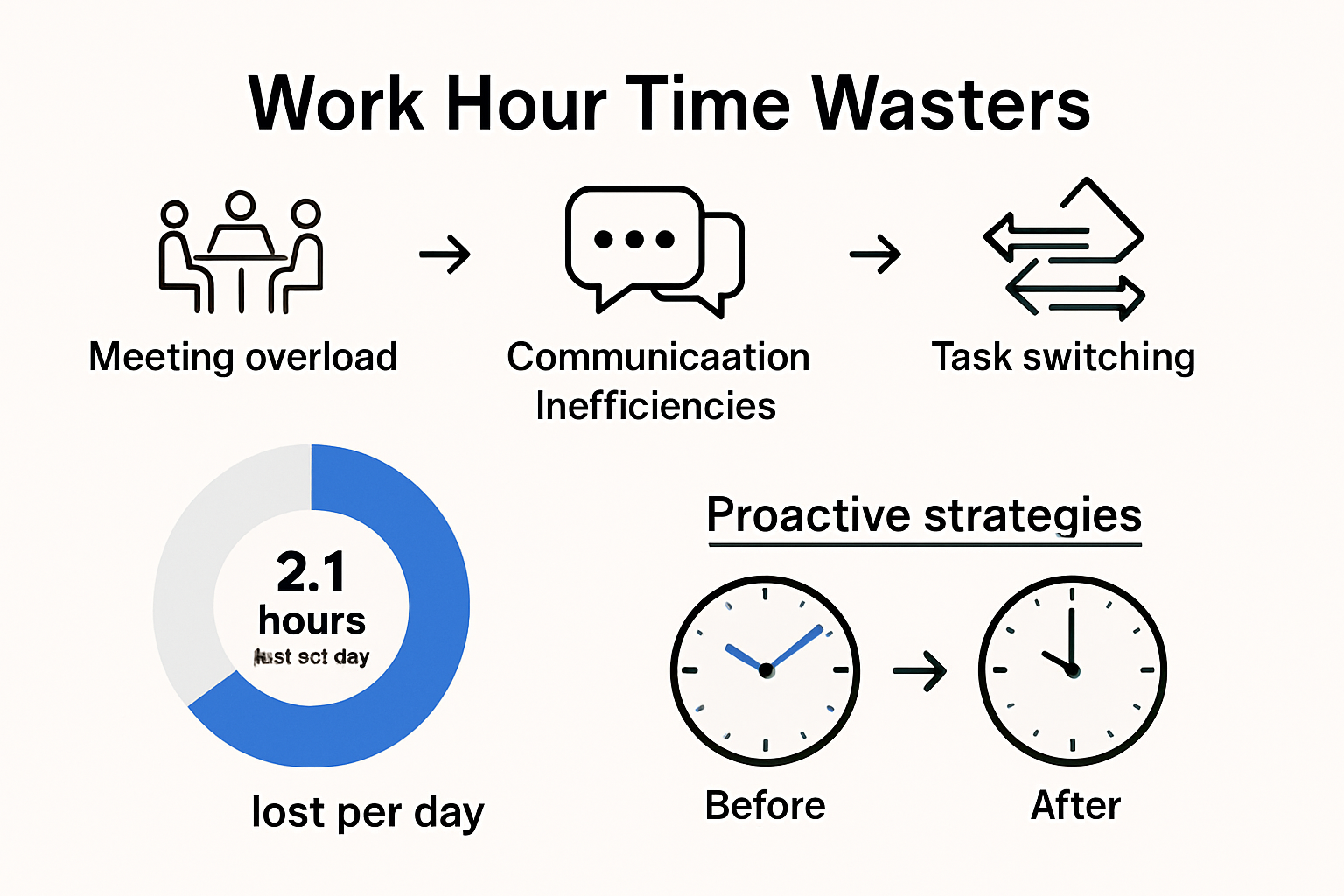Cutting wasted work hours might sound impossible in fast-paced offices where everyone is busy from dawn till dusk. Yet research shows that the average professional actually loses about 2.1 hours every day to non-essential tasks—over a quarter of their entire workweek evaporates into thin air. Here is what leaders rarely notice: the biggest gains in productivity do not come from working harder but from spotting and eliminating those hidden time drains that quietly drain resources and stifle progress.
Table of Contents
- Identifying Time Wasters In The Workplace
- Practical Automation And Delegation Tips
- Building Efficient Team Schedules
- Using Digital Tools To Save Work Hours
Quick Summary
| Takeaway | Explanation |
|---|---|
| Identify and Eliminate Time Wasters | Conduct periodic audits to pinpoint inefficiencies that drain productivity and establish clear workflows to rectify them. |
| Embrace Strategic Delegation | Use the Eisenhower Matrix to categorize tasks, matching them to team members based on strengths and development goals. |
| Leverage Automation for Tasks | Implement digital tools to automate repetitive tasks like scheduling, communication, and reporting to enhance team productivity. |
| Optimize Team Schedules | Create schedules that align with team members’ peak productivity periods and adapt to changing workloads for maximum efficiency. |
| Utilize Advanced Digital Tools | Integrate sophisticated digital tools that enhance communication, track performance, and enable real-time decision-making to streamline operations. |
Identifying Time Wasters in the Workplace
Time is the most critical resource for leaders and organizations. Understanding and eliminating workplace time wasters can significantly boost productivity and organizational efficiency. Learn how to optimize your team’s workflow by first recognizing the most common productivity killers.
The Hidden Costs of Inefficient Work Practices
Workplace time wasters are more than just minor annoyances. According to a study by the U.S. Government Accountability Office, ineffective meetings, excessive communication, and unclear priorities can drain substantial organizational resources. Research reveals that the average professional loses approximately 2.1 hours per day to non-essential activities, translating to nearly 26% of their workweek being unproductive.
The financial implications are staggering. When employees spend significant time on unproductive tasks, organizations essentially pay for work that generates minimal value. This waste includes unnecessary meetings, redundant email threads, constant task switching, and prolonged decision making processes.
To clearly illustrate the most common sources of wasted time in the workplace and their impact, the following table summarizes key time wasters and their effects as described in recent research.
| Time Waster | Description | Estimated Impact |
|---|---|---|
| Meeting Overload | Excessive or poorly structured meetings consume work hours | Significant; 2.1 hrs lost daily |
| Communication Inefficiencies | Redundant emails, unclear protocols lead to wasted time | High; contributes to 26% lost weekly |
| Task Switching Complexity | Constant interruptions and multitasking reduce productivity | Up to 23 minutes lost per interruption |
| Unclear Priorities | Lack of clear goals causes focus issues and rework | Substantial cumulative effect |
| Prolonged Decision Making | Slow, convoluted processes delay progress | Loss of productive work time |
Systematic Identification of Time Drain Sources
Identifying time wasters requires a structured approach. Research published in the International Journal of Environmental Research and Public Health recommends several strategic methods for diagnosing productivity bottlenecks:
-
Meeting Overload: Excessive or poorly structured meetings consume significant work hours. Leaders should critically evaluate meeting frequency, duration, and participant list.
-
Communication Inefficiencies: Redundant email chains, unnecessary communications, and lack of clear communication protocols create significant time waste.
-
Task Switching Complexity: Constant interruptions and multitasking dramatically reduce individual and team productivity. Each interruption can cost up to 23 minutes of productive time.

Proactive Strategies for Time Waste Elimination
Recognizing time wasters is only the first step. Successful leaders implement systematic approaches to minimize productivity drains. This involves creating clear workflows, establishing communication guidelines, implementing focused work periods, and leveraging technology to streamline processes.
Critical actions include conducting periodic productivity audits, using time tracking tools, encouraging focused work environments, and training teams on efficient work practices. By systematically addressing these challenges, organizations can reclaim substantial productive hours and create a more efficient workplace culture.
Practical Automation and Delegation Tips
Time management for leaders goes beyond identifying problems it requires strategic solutions. Explore advanced automation strategies that transform how teams operate and maximize productivity.
Understanding the Power of Strategic Delegation
Delegation is not about offloading work but empowering teams. According to Purdue University’s Department of Agricultural Economics, effective delegation involves systematically categorizing tasks using the Eisenhower Matrix. This method helps leaders distinguish between urgent, important, not urgent, and non-essential tasks.
Successful delegation requires precise skill. Leaders must match tasks with team members based on their strengths, capabilities, and professional development goals. This approach not only distributes work efficiently but also builds team capacity and individual confidence.
Automation Techniques for Enhanced Productivity
Modern technology offers unprecedented opportunities for task automation. Repetitive administrative tasks such as scheduling, data entry, reporting, and communication can be significantly streamlined through intelligent tools. Key automation strategies include:
The following table summarizes key automation techniques discussed and their primary benefits for workplace productivity.
| Automation Technique | Main Benefit |
|---|---|
| Workflow Automation | Reduces manual task routing and tracking |
| Communication Streamlining | Handles routine inquiries, saves time |
| Reporting and Analytics | Compiles data and insights automatically |
| Scheduling Automation | Eases planning and reduces admin workload |
| AI-Powered Tools | Enables smarter performance tracking |
-
Workflow Automation: Implement digital tools that automatically route tasks, send notifications, and track progress without manual intervention.
-
Communication Streamlining: Use AI-powered chatbots and automated communication platforms to handle routine inquiries and information distribution.
-
Reporting and Analytics: Leverage automated reporting systems that compile data, generate insights, and provide real time performance metrics.
Balancing Delegation and Personal Oversight
The Niagara Institute’s comprehensive delegation guide emphasizes the critical balance between delegating effectively and maintaining appropriate leadership oversight. Successful delegation is not about completely removing oneself from the process but creating clear expectations, providing necessary resources, and establishing robust feedback mechanisms.
Leaders should develop a structured approach to delegation that includes:
- Clear task descriptions and expected outcomes
- Appropriate training and support for team members
- Regular check-ins and progress monitoring
- Constructive feedback and continuous improvement protocols
By mastering the art of strategic delegation and intelligent automation, leaders can dramatically reduce administrative burdens, focus on high-value strategic work, and create a more agile, responsive organizational environment. The goal is not just saving time but creating a more empowered, efficient workplace ecosystem.
Building Efficient Team Schedules
Effective team scheduling is a critical component of organizational productivity that directly impacts work hours and overall performance. Strategic schedule design goes beyond simply allocating work hours—it involves creating a dynamic framework that maximizes team potential and minimizes productivity friction.
Understanding Schedule Optimization Principles
Schedule optimization is a complex science that requires careful analysis of team dynamics, individual capabilities, and organizational goals. Research from the National Institutes of Health demonstrates that thoughtful schedule design can significantly reduce unnecessary labor hours while maintaining high performance levels.
Key principles of effective scheduling include understanding each team member’s peak productivity periods, aligning work tasks with individual strengths, and creating flexible structures that accommodate different working styles. This approach recognizes that not all team members operate at maximum efficiency during traditional 9-to-5 timeframes.
Strategic Scheduling Techniques
Modern leaders must adopt sophisticated scheduling strategies that transcend traditional time management approaches. Critical techniques include:
-
Peak Performance Mapping: Identify and schedule complex tasks during individual team members’ most productive hours
-
Collaborative Time Blocking: Create dedicated periods for team collaboration and individual deep work
-
Adaptive Scheduling: Implement flexible scheduling models that allow for real-time adjustments based on project demands and team capacity
Technology-Enabled Schedule Management
Advanced scheduling requires leveraging technology to create intelligent, responsive work frameworks. Digital tools now enable precise tracking of work patterns, predictive scheduling, and seamless communication across distributed teams.
Effective schedule management involves:
- Utilizing AI-powered scheduling algorithms
- Implementing transparent shared calendars
- Creating clear communication protocols for schedule adjustments
- Developing robust backup plans for unexpected disruptions
The goal of efficient team scheduling is not just reducing work hours but creating an adaptive, responsive work environment that maximizes human potential. By treating scheduling as a strategic tool rather than an administrative task, leaders can unlock unprecedented levels of team productivity and individual satisfaction.
Successful schedule design requires continuous refinement, open communication, and a willingness to experiment with new approaches. The most effective teams view scheduling as a dynamic process—constantly evolving to meet changing organizational needs and individual capabilities.

Using Digital Tools to Save Work Hours
In the modern workplace, digital tools have become essential for transforming operational efficiency and saving valuable work hours. Discover cutting-edge productivity strategies that leverage technology to streamline workflows and maximize team performance.
Digital Time Management Fundamentals
Digital tools are more than just technological conveniences—they are strategic assets for organizational productivity. Research published in Administrative Sciences demonstrates that implementing sophisticated digital management systems can significantly enhance workforce efficiency, accountability, and transparency.
Modern digital tools enable leaders to track, analyze, and optimize work processes with unprecedented precision. These technologies provide real-time insights into team performance, resource allocation, and potential productivity bottlenecks. By transforming raw data into actionable intelligence, organizations can make informed decisions that directly impact work hour optimization.
Strategic Digital Tool Implementation
Successful digital tool integration requires a comprehensive approach that goes beyond simple technology adoption. Key strategies include:
-
Comprehensive Workflow Analysis: Use digital tools to map existing work processes, identifying inefficiencies and potential improvement areas
-
Integrated Communication Platforms: Implement unified communication systems that reduce time spent on coordination and information sharing
-
Automated Reporting Systems: Leverage AI-powered tools that generate comprehensive reports with minimal manual intervention
Advanced Digital Productivity Technologies
According to research from the National Center for Biotechnology Information, digital technologies can dramatically improve organizational decision-making and service quality. Advanced tools now offer capabilities that extend far beyond basic task management:
- Artificial intelligence-powered task prioritization
- Predictive analytics for resource allocation
- Machine learning algorithms that optimize individual and team workflows
- Real-time performance tracking and feedback mechanisms
The most effective digital tools are those that seamlessly integrate into existing workflows, providing intuitive interfaces and meaningful insights. Leaders must approach digital tool selection with a strategic mindset, focusing on solutions that offer genuine productivity enhancements rather than adding unnecessary complexity.
Ultimately, digital tools are not about replacing human expertise but augmenting human capabilities. By selecting the right technologies and implementing them thoughtfully, organizations can create more agile, responsive, and efficient work environments that respect both technological potential and human potential.
Frequently Asked Questions
What are common time wasters in the workplace?
Common time wasters in the workplace include excessive meetings, inefficient communication, task switching, unclear priorities, and prolonged decision-making processes. Identifying these can help leaders streamline productivity.
How can automation improve work hour efficiency?
Automation can enhance work hour efficiency by reducing the time spent on repetitive tasks such as scheduling, data entry, and reporting, allowing employees to focus on higher-value work.
What is strategic delegation, and how can it be implemented?
Strategic delegation involves matching tasks to team members based on their strengths and development goals using frameworks like the Eisenhower Matrix. This ensures tasks are handled by the most capable individuals, improving overall productivity.
How can leaders optimize team schedules?
Leaders can optimize team schedules by mapping out team members’ peak productivity periods, adopting flexible scheduling techniques, and utilizing technology for real-time adjustments, ensuring that work aligns with individual strengths and project demands.
Ready to Turn Hidden Time Wasters Into Real Productivity?
Are you tired of seeing crucial hours slip away to endless meetings and repetitive admin? The strategies in this article show that real transformation starts with the courage to identify and attack inefficiencies head-on. But lasting results require smart tools that automate, delegate, and organize—all at once—so you actually get those hours back.

See how Gammatica.com can help you reclaim your workweek. With features designed for leaders, like AI-powered task management, automated workflows, built-in meeting integrations, and real-time time tracking, the platform tackles your biggest frustration: wasted hours. Explore how you can bring these AI-driven automation strategies into your team’s daily routine and simplify your processes. Don’t wait until the next productivity drain derails your projects. Visit Gammatica.com now to start streamlining your operations and save up to 16 hours each week.
Recommended
- How to Manage Tasks Effectively in 2025: Proven Strategies for Leaders | Gammatica
- Automation for Small Businesses: Essential Strategies for 2025 | Gammatica
- Project Progress Tracking: Strategies for Success in 2025 | Gammatica
- Collaborative Decision Making for Leaders: Strategies for 2025 | Gammatica



